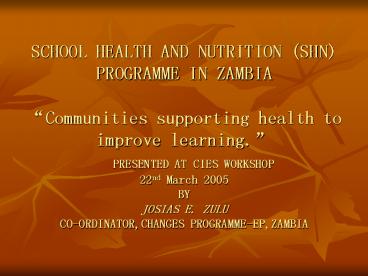SCHOOL HEALTH AND NUTRITION (SHN) PROGRAMME IN ZAMBIA - PowerPoint PPT Presentation
1 / 12
Title:
SCHOOL HEALTH AND NUTRITION (SHN) PROGRAMME IN ZAMBIA
Description:
SCHOOL HEALTH AND NUTRITION (SHN) PROGRAMME IN ZAMBIA ' ... JOSIAS E. ZULU. CO-ORDINATOR,CHANGES PROGRAMME-EP,ZAMBIA. Conceptual Framework of ... – PowerPoint PPT presentation
Number of Views:632
Avg rating:3.0/5.0
Title: SCHOOL HEALTH AND NUTRITION (SHN) PROGRAMME IN ZAMBIA
1
SCHOOL HEALTH AND NUTRITION (SHN) PROGRAMME IN
ZAMBIA Communities supporting health to
improve learning. PRESENTED AT CIES
WORKSHOP22nd March 2005 BYJOSIAS E.
ZULUCO-ORDINATOR,CHANGES PROGRAMME-EP,ZAMBIA
2
Conceptual Framework of SHN/CHANGES Program
- Trainings
- Community mobilization and advocacy
- Community-based interventions
- School-based interventions
- Impact and outreach
3
The SHN activities
- Baseline survey- biomedical, anthropometric and
cognitive assessments - Micronutrients supplements (Iron tablets and Vit.
A) and de-worming pills (Albendazole) once per
year - Training teachers in Drug Administration and Life
skills - Strengthening linkages between Health centres and
schools - Providing small grants to schools and communities
to support SHN and HIV/AIDS interventions - Community mobilisation to support SHN activities
as a cross cutting activity
4
Mobilizing Institutions for School Health and
Nutrition
- Roles and responsibilities of Ministries of
Education and Health agreed upon - School and health and nutrition policy developed
- Multi-sectoral committees established
- Link Schools to Health centres and communities
(through School Health cards) - Characteristics of a Health promoting
School-Multi-sectoral teams.
5
Mobilizing Communities for School Health and
Nutrition. (SHN).
- Use of Participatory Learning for Action (PLA)
and Theatre for Community Action (TCA) - Public meetings
- Training of teachers and health workers in
HIV/AIDS and SHN activities - Training of communities and teachers SHN
concept, PLA and TCA - Sub grants to Community Based Organisations
(CBOs) groups Supporting SHN activities - Develop and distribute IEC materials on SHN
6
Examples of Community Participation.
- Molding of bricks and labour for construction of
resource centres, wells and pit latrines and
School gardens - Cooking on school feeding days
- Dissemination of information to pupils and other
community members - Parents provide snacks to their children to carry
with them to school - Decision making and planning
7
Using the Media at National and Local Level
- Focus on benefits of SHN, Role of
communities, How to make children healthy,
Prevention of diseases-Water and sanitation - Parents, pupils and teachers are involved in
the discussions - Local and National Radio programmes
- National TV programs
- National Newspapers
- IEC materials newsletters, flipcharts,
brochures, calendars etc.
8
Impact.
- Pupils more alert and healthier
- Absenteeism reduced
- Communities more concerned about the health of
their children - Cognitive functions of pupils improved
- Health center attendances by pupils reduced
- Cost effective
9
Challenges.
- Teachers- extra duty vs extra pay, Competence,
mouthful of activities - Health workers-Professional jealousy, are
teachers competent? - Community- Competence, Not serious, Not sure of
the benefit, Myths and misconceptions about drug
administration to pupils. Is this Satanism. Does
my religion allow? - Overcoming bad cultural beliefs and practices
10
Nyau Dancer- Eastern Province Zambia.
11
Lessons learnt
- Popular drama is effective but expensive when
professionals are used. However, equally
effective are meetings and local drama groups - Training must go beyond teachers and health
workers to include managers, policy makers and
Community members with their opinion leaders - Poor infrastructure has no serious effect in
implementation of the program - Health workers, Teachers and Communities can work
together as partners to improve learning
12
Conclusions.
- Involving teachers is the best practice Teachers
work closely with parents and exert influence on
the welfare of school children community members
trust teachers ability to learn and adapt to new
ideas - Teachers, Health workers and community members
can work together to improve learning. Training
teachers and health workers together builds team
work.































